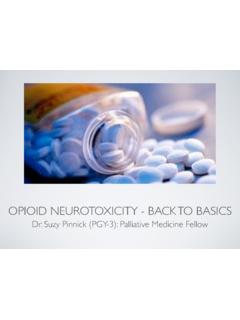Transcription of Cancer Biochemistry Tumour makers - City Assays
1 10/01/20171 Cancer Biochemistry and Tumour makersJames PethickClinical ScientistSandwell and West Birmingham HospitalsKNOWLEDGE Understand the different types of Tumour and the disorders in Biochemistry they can cause. Understand the staging of Tumour growth and the implications for the patient biochemically. Understand the appropriate use of Tumour markers in screening, diagnosis and monitoring malignant disease. Be aware of the criteria for the ideal Tumour marker. Be aware of clinical sensitivity and specificity of methods, problems with cross reactivity and prozone effects.
2 Understand the possible biochemical consequences of Tumour growth such as ectopic hormone production. Be aware of the roles of faecal occult blood, PSA, CEA, CA125, CA153, CA19 9, AFP, HCG, HIAA, catecholamines and metadrenalines and how these Assays maybe performed. Understand the sample requirements for Tumour marker measurement and possible interferences or cross You must be able to: Explain the physiological significance of Tumour marker measurements. Give examples of routinely used Tumour markers and how they are used appropriately. Locate information for sample requirements for Tumour marker tests and be able to give advice to clinicians regarding sample types.
3 Explain the methodological techniques used to measure Tumour markers and how different methods and standards used may alter results Cancer STATISITCSD iagnoses per day?Males?FemalesBiggest risk?Highest incidence?980, 1 every 2 minutes181,000176,000 Age+85 years1 in 2 people born after 1960 will be diagnosed with some form of Cancer during their lifetime4 in 10 Cancer cases are linked to lifestyle factorsSmoking is the largest single preventable cause of Cancer each year in the UKAccessed from professional/ Cancer statisticson 04/12/1610/01/20173 There are over 200 types of Cancer but Breast, Lung.
4 Prostate and Bowel Cancer account for 53% of all cancers in the UKBREAST CANCERThe most common Cancer in the UK and accounts for 15% of all new cases per yearAlmost half breast Cancer cases are diagnosed in women over 65 yearsThere were 390 new cases of breast Cancer in males in 2014 Breast Cancer is less common in women who live in deprived areas and is more common in White females than Asian or Black femalesAccessed from professional/ Cancer statisticson 04/12/1610/01/20174 Mother died of ovarian Cancer BRCA1 is a Tumour suppressor gene it fixes damaged DNA There are >1800 known mutations in BRCA1 cause truncation of BRCA1 protein BRCA1 mutations inherited and cancers cluster within families BRCA1 mutation severely increases your risk of developing breast and ovarian Cancer If worried your GP can refer you to genetics for predictive genetic testingLUNG CANCERThe third most common Cancer in the UK and accounts for 13% of all new cases per Cancer incidence has been decreasing since the 1970s.
5 This includes an increased incidence in Cancer is more common in people living in deprived areas and is more common in males than females and White people compared to Asian or Black biggest Cancer related cause of death in males and survival has not shown much improvement in the last 40 at an early stage 1/3 people survive for 5 or more years, but often diagnosed at a late from professional/ Cancer statisticson 04/12/1610/01/20175 PROSTATE CANCERMore than half prostate Cancer cases are diagnosed in men over 70 years, highest incidence over 90 yearsProstate Cancer incidence has increased by 155% since the 1970s, this is linked with PSA testing, and is projected to rise by 12% by 2035 Less common in men living in deprived areas and least common in Asian men and most common in Black men1 in 8 men will be diagnosed with prostate Cancer in their lifetimeAccessed from professional/ Cancer statisticson 04/12/16 BOWEL CANCERThe forth most common form of Cancer in the UK44% of cases pa are diagnosed in people over 75 years.
6 With the highest incidence in 85 to 89 yr oldsSince the 70s incidence has increased and the increase is more in males (19%) than female (3%)Most bowel Cancer is diagnosed at a later stage and occur in the common in males living in deprived areas in England, there is no association for from professional/ Cancer statisticson 04/12/1610/01/20176 Cancer CATEGORIES Classified depending on the tissue from which they arise: Carcinomasarise from epithelial cells and are by far the most common Sarcomasare cancers that begin in connective tissue such as bone, cartilage, fat, muscle and blood vessels Leukaemiasstart in blood forming tissue such as bone marrow and result in production of large numbers of abnormal blood cells to be produced and enter circulation Lymphomaand myeloma are cancers of the immune system Central nervous system tumours arise from tissues in the brain and spinal cordCANCER.
7 A disease of uncontrolled cell growthPathogenesis of Cancer is driven by genetic changes, mostly acquired,but some are hereditary causing a predisposition to developing cancer1. Autonomy of growth signals2. Insensitivity to growth inhibitory signals3. Evasion of programmed cell death4. Unlimited replication potential5. Angiogenesis6. Invasion and metastasis10/01/20177 Cancer : A disease of uncontrolled cell growth Cancer cells reproduce in defiance of normal restraints on cell growth and division and invade and colonise other territories usually reserved for other cell types A cell that grows and proliferates out of control gives rise to a Tumour neoplasm Benign Malignant Pre malignantA Tumour is considered a Cancer only if itismalignant when its cells haveacquired the ability to invade other tissuesTumour cells that invade other tissues arecalledmetastases Generally it is themetastases that kill Cancer patientsTUMOUR STAGINGA.
8 Normal stratified squamous epithelium with dividing cells confined to the basal layerB: low grade intraepithelial neoplasia, dividing cells throughout lower third of epithelial layerC: In high grade intraepithelial neoplasia cells in all layers of the epithelium are proliferating and have defective differentiationD: True malignancy occurs when cells move through or destroy the basal lamina underlying the epithelium and invades the connective tissueImage from Alberts et al. The Molecular Biology of The Cell 5thEd. Image 20 9. Accessed from 04/12/201610/01/20178 Tumour PROGRESSIONS uccessive cycles of random inherited change followed by natural each cycle cells develop genetic or epigenetic changes giving them selective advantage over other environment within a Tumour is hostile to cells with low oxygen, scare nutrients.
9 And natural barriers to growth presented by surrounding and nutrients do not become limiting until the lesion is 1 2mm in diameter so cells in the core of the Tumour must acquire addition changes to continue to of each clone hastens the occurrence of the next step of Tumour progression by increasing the size of the cell population at risk of undergoing additional from Alberts et al. The Molecular Biology of The Cell 5thEd. Image 20 11. Accessed from 04/12/2016 Tumour STAGING: ClassificationMost solid tumours are staged using the TNM system T the extent of the Tumour N the extent of spread to lymph nodes M the presence of metastasesTxPrimary Tumour could not be assessedT0No evidence of primary tumourTisCarcinoma in situT1 4 Size and/or extent of primary tumour1= small Tumour with minimal invasion4= large Tumour with extensive invasionNxNodes cannot be assessedN0No node involvementN1 3 Regional node metastasesM0No distant spreadM1 Distant metastases10/01/20179 Cancer SIGNS AND SYMPTOMSL ocal effects Depends on the Tumour Lung blockage
10 Of bronchus cough and pneumonia Esophageal narrowing of esophagus painful/difficult to swallow Colorectal narrowing of the bowel change in bowel habits Local bleeding rectal, coughing up blood, vaginal bleeding, blood in urineSystemic effects Unexpected weight loss Unexplained fever Fatigue Back painMETABOLIC CONSEQUENCES OF Cancer During Tumour growth the nutritional and metabolic state of the host changes in favour of the neoplasm Metabolic changes can result directly from the presence of the Tumour or secondary to secretory products of the Tumour , these are known as paraneoplastic syndromes10/01/201710 METABOLIC CONSEQUENCES OF Cancer Marked derangements of carbohydrate metabolism are a feature of malignancy Impaired glucose tolerance, hyper/hypoglycaemia, lactic acidosis, increased glucose turnover and increased transport of glucose into Tumour cells.







